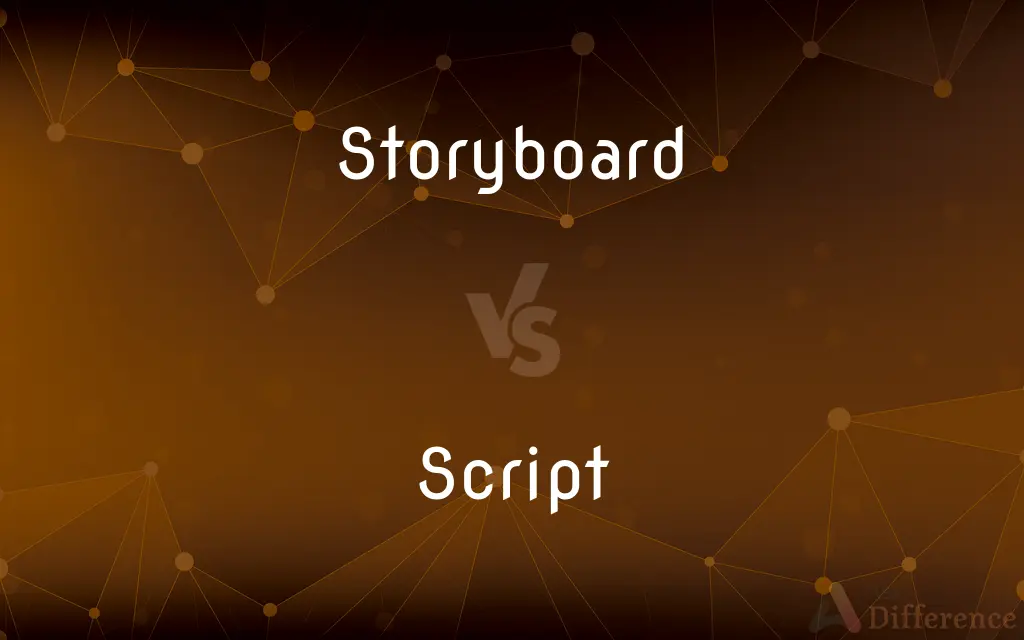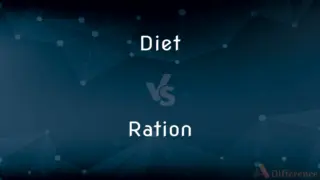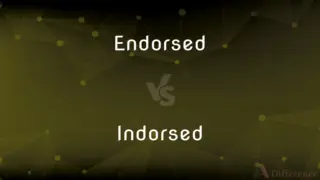Storyboard vs. Script — What's the Difference?
By Maham Liaqat & Urooj Arif — Updated on May 6, 2024
A storyboard visually outlines a film or animation scene by scene, using images or sketches, while a script provides detailed written descriptions, including dialogue and action instructions.

Difference Between Storyboard and Script
Table of Contents
ADVERTISEMENT
Key Differences
A storyboard is a sequence of drawings that represents the shots planned for a film or animation, providing a visual layout of events as they are to unfold on screen. On the other hand, a script is a comprehensive text document that includes all spoken dialogue, as well as detailed descriptions of characters' actions, settings, and other narrative elements.
While storyboards focus on the visual aspects of storytelling, helping directors and cinematographers visualize scenes and transitions, scripts delve into the specifics of language, character interaction, and stage directions. The script forms the backbone of the narrative, whereas the storyboard helps in visualizing the narrative's execution.
Storyboarding often serves as a crucial tool for communication among various production team members, including directors, cinematographers, and special effects teams. It visually conveys what is to be shot, making it easier for these teams to prepare their work. On the other hand, scripts are primarily used by writers, directors, and actors to understand and perform the narrative and dialogue.
In terms of usage, storyboards are particularly valuable in complex sequences involving action or special effects, where visual planning is essential to coordinate efforts and manage resources efficiently. Scripts, however, are indispensable throughout the production process, guiding every aspect of the performance and ensuring narrative coherence.
Both storyboards and scripts undergo revisions and updates as a project evolves from the pre-production to the production phase. However, changes to the script typically have broader implications, potentially affecting dialogue, character development, and plot progression, while storyboard changes are usually focused on visual elements and scene logistics.
ADVERTISEMENT
Comparison Chart
Definition
Visual outline of scenes using drawings
Detailed written description of a narrative
Primary Focus
Visual planning of shots and scenes
Dialogue, character actions, and settings
Usage in Production
Communication among visual and technical teams
Guiding performances and narrative execution
Value
Essential in planning complex visual sequences
Indispensable for overall production coherence
Changes
Typically visual elements and scene logistics
Can affect dialogue, plot, and character interactions
Compare with Definitions
Storyboard
A pre-visualization technique used in film-making.
Storyboarding helped visualize the sequence before actual filming.
Script
Essential component for dialogue and character development.
Script revisions focused on deepening the protagonist’s emotional journey.
Storyboard
Tool for communicating scene layout and camera movements.
The storyboard clearly marked the camera angles for each scene.
Script
Written text of a film or play, including dialogue and action.
The actor studied his lines in the script for weeks.
Storyboard
A framework used to outline a story visually.
The animation team developed a detailed storyboard to outline each episode.
Script
Basis for narrative and performance in productions.
The director made several changes to the script to enhance the story's impact.
Storyboard
A sequence of drawings representing the shots of a film.
The director reviewed the storyboard to ensure alignment with her vision.
Script
The blueprint for all elements of a theatrical or film production.
Every aspect of production was detailed in the final script.
Storyboard
Visual planning tool for films and animations.
The storyboard artist depicted complex action scenes to guide the cinematographer.
Script
A document detailing characters, settings, and actions in scenes.
The script contained detailed descriptions of each character’s background.
Storyboard
A storyboard is a graphic organizer that consists of illustrations or images displayed in sequence for the purpose of pre-visualising a motion picture, animation, motion graphic or interactive media sequence. The storyboarding process, in the form it is known today, was developed at Walt Disney Productions during the early 1930s, after several years of similar processes being in use at Walt Disney and other animation studios.
Script
Handwriting.
Storyboard
A rough, pictorial outline of the different scenes, camera angles, or perspectives in a movie or interactive sequence, such as a video game.
Script
A style of writing with cursive characters.
Storyboard
A series of drawings that lay out the sequence of scenes in a film or series, especially an animated one.
The storyboard process helps promote brainstorming, highlights missing tasks, and allows the team to incorporate changes prior to traveling too far down a particular path. — By Cheryl A. Malloy & William Cooley, NASA & SAIC [https://web.archive.org/web/20061004060447/http://appel.nasa.gov/ask/issues/13/practices/index.html here]
Script
A particular system of writing
Cuneiform script.
Storyboard
Any sequence of drawings or diagrams which illustrate a sequence of events, e.g. in an accident or as a flowsheet for computer programming.
Script
A style of type that imitates handwriting.
Storyboard
To create and arrange storyboard drawings.
Storyboarding allows students to work together as they generate ideas and eliminates the territorial defensiveness that often occurs when new ideas are suggested. — "Using Storyboarding to Determine components of Dellness for University Students" J Am Coll Health. 1996 Jan;44(4):180-3 [http://www.ncbi.nlm.nih.gov/entrez/query.fcgi?cmd=Retrieve&db=PubMed&list_uids=8583044&dopt=Abstract Abstract]
Script
The matter set in this type.
Script
The text of a play, broadcast, or movie.
Script
A copy of a text used by a director or performer.
Script
(Law) The original of a legal instrument, as opposed to a copy.
Script
(Computers) A simple program in a language that the computer must convert to machine language each time the program is run.
Script
To prepare (a text) for filming or broadcasting.
Script
To arrange, direct, or control (an event or a person) as if supplying a script
"the brilliant, charming, judicial moderate scripted by his White House fans" (Ellen Goodman).
Script
(Computers) To write (code) for a program.
Script
A writing; a written document.
Script
Written characters; style of writing.
Script
(typography) Type made in imitation of handwriting.
Script
An original instrument or document.
Script
(countable) The written document containing the dialogue and action for a drama; the text of a stage play, movie, or other performance. Especially, the final form used for the performance itself.
Script
(computing) A file containing a list of user commands, allowing them to be invoked once to execute in sequence.
Script
(psychology) A behavioral script; sequence of actions in a given situation.
Script
(linguistics) A system of writing adapted to a particular language or set of languages.
Script
(informal) prescription for drugs or medicine
Script
(transitive) To make or write a script.
Script
(transitive) To devise, concoct, or contrive.
Script
A writing; a written document.
Script
Type made in imitation of handwriting.
Script
An original instrument or document.
Script
Written characters; style of writing.
Script
A written version of a play or other dramatic composition; used in preparing for a performance
Script
Something written by hand;
She recognized his handwriting
His hand was illegible
Script
A particular orthography or writing system
Script
Write a script for;
The playwright scripted the movie
Common Curiosities
What is the main purpose of a storyboard?
The main purpose of a storyboard is to visually plan and communicate the sequence of events in a film or animation.
Who typically uses a storyboard?
Directors, cinematographers, and visual effects teams typically use storyboards to plan and execute film scenes.
Do storyboards include dialogue?
Storyboards generally do not include dialogue; they focus more on visual elements, although brief descriptions or dialogue cues might be added.
Can a film be made without a storyboard?
Yes, a film can be made without a storyboard, especially if it is dialogue-heavy and not visually complex, but storyboards are crucial for visual planning in most films.
How does a script differ from a storyboard in film production?
A script provides the textual details including dialogue and action, while a storyboard provides a visual representation of scenes.
Is a script necessary for all types of productions?
Yes, scripts are fundamental to almost all types of theatrical and film productions as they outline the narrative and dialogue.
What are the benefits of using a storyboard in animation?
In animation, storyboards are essential for defining the flow of the story, planning animations, and synchronizing voice-overs with actions.
Can a storyboard be used for live performances?
Yes, storyboards can be adapted for live performances, particularly for planning complex scenes or visual effects.
Why is a script considered the backbone of a film?
It is considered the backbone because it lays out the essential narrative structure, character development, and dialogue on which the film is built.
How detailed is a script compared to a storyboard?
A script is more detailed in terms of narrative elements like dialogue and character actions, while a storyboard focuses on visual details.
How do changes in the script affect production?
Changes in the script can alter dialogue, character development, and plot, impacting nearly every aspect of production.
What skills are required to create a storyboard?
Skills required include drawing, understanding of cinematography, and the ability to visually represent narrative sequences.
How are script revisions communicated to the production team?
Script revisions are usually communicated through updated scripts distributed to the cast and crew.
What role does a storyboard play in a film's pre-production?
In pre-production, a storyboard helps visualize and plan the entire film, aiding in logistics, setting design, and scene preparation.
What type of information is typically excluded from a storyboard?
Detailed character dialogue and intricate background settings are typically excluded from a storyboard.
Share Your Discovery

Previous Comparison
Diet vs. Ration
Next Comparison
Endorsed vs. IndorsedAuthor Spotlight
Written by
Maham LiaqatCo-written by
Urooj ArifUrooj is a skilled content writer at Ask Difference, known for her exceptional ability to simplify complex topics into engaging and informative content. With a passion for research and a flair for clear, concise writing, she consistently delivers articles that resonate with our diverse audience.
















































